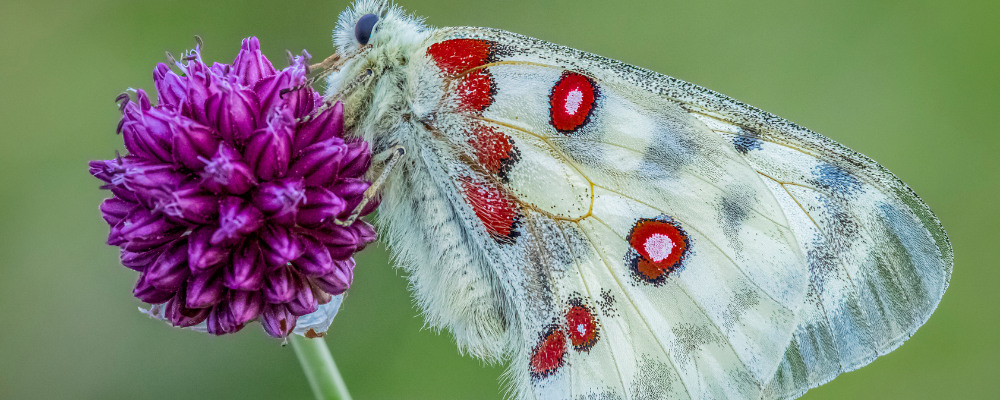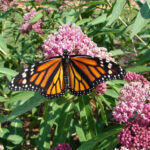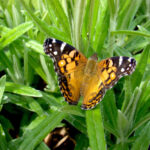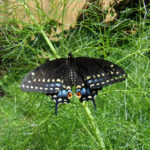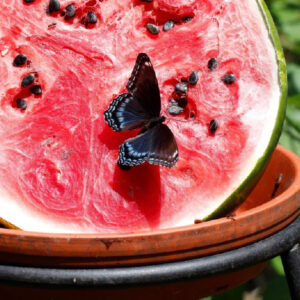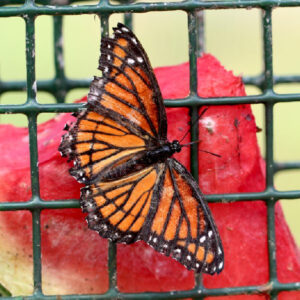By Brenda Dziedzic
Nature is a soothing place where one can find peace.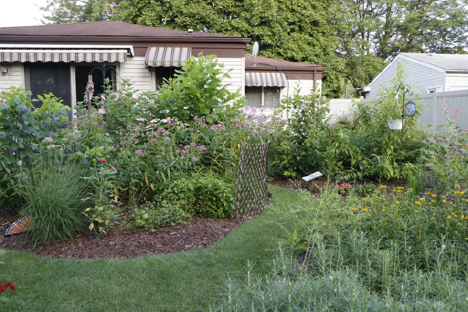
I feel it when I’m in my garden, which I designed specifically to attract butterflies and moths. It’s very relaxing being surrounded by these beautiful insects as they flutter around my yard, going about their business as I watch in awe.
I’ve always had a love for nature. Years ago, in the late summer of 2001, the thought came to me that it would be nice to see more butterflies in my yard like I used to see when I was a child.
What could I do?
I decided to create a butterfly garden and went out and bought my first three butterfly bushes. After more research and consulting with a knowledgeable garden center employee, I got a list of necessary plants for my garden. (Note: please be sure you plant interspecific hybrids only. Other butterfly bushes are deemed invasive in Oregon. Your garden center can help you.)
That was it. I was hooked. From then on, I read every book I could find about butterflies and moths.
Since then, I have raised thousands of butterflies and moths. I bring most of the eggs that I find in the garden into my house so that I can help the butterflies since a lot of their habitat is being destroyed. When they come out of their chrysalises, cocoons, and pupae, I release them back into the garden. I have gained a lot of knowledge about butterflies and moths by observing their life cycles and taking the time to help them flourish.
Even a small yard can have butterflies and moths
Anyone can have a variety of butterflies and moths in their yard by planting the plants that butterflies and moths use. Even though I have a small city lot, which is 60 feet by 120 feet, there are many different species of butterflies and moths in my yard because of the diversity of host plants. Each year, I increase my variety of host and nectar plants. If the butterflies and moths can complete their life cycles in your yard, you’ll have more fluttering about than you would by growing only nectar plants.
I share my knowledge about raising butterflies and moths with as many people as possible. We need to give back to the earth, and we can do this by planting the right plants which enhances an area’s overall biodiversity.
Attracting and raising butterflies and moths
First off, butterflies and moths make up the insect order Lepidoptera. Lepidoptera is derived from the Greek words “lepido” for scale and “ptera” for wings.
- Butterflies are generally diurnal (day flying), have thin and smooth bodies, hold their wings upright over their backs when at rest, are colorful, and have clubbed antennae.
- Moths are generally nocturnal (night flying), have fat hair-like scales on their bodies, fold their wings over their backs like tents or wrap them over their bodies when at rest, are dull colored, and have thread-like or feathery antennae.
- Include nectar plants for food
In order to have both butterflies and moths in the garden, there have to be plants that attract them. Nectar plants are food for butterflies and moths. The nectar contains carbohydrates and amino acids which are needed for egg production. It’s also important to have flowers that bloom at different times of the year. This will ensure that they have nectar to feed on.
- Plant host plants
Another key element is to plant host plants as well. Host plants are the plants that they lay eggs on and that the caterpillars feed on. When planting host plants, it’s best to plant in multiple locations to prevent as much predation of eggs and caterpillars. A couple of examples of host plants you can plant to attract them are fennel for the Black Swallowtail, Pearly Everlasting for the American Lady, and milkweed for the Monarch.
- Don’t use pesticides
Don’t use pesticides in your garden because pesticides will kill the eggs, caterpillars, butterflies, and moths.
- Plant in a sunny location
Another important aspect is to try to plant the garden in a sunny location since most butterfly and moth plants need at least 6 hours of sun per day. When planting, plant in groups of three or more. This is important because butterflies and moths are nearsighted and grouping plants make it easier for them to spot them. That will also ensure that there is enough food for the caterpillars to complete their metamorphosis.
- Supply overripe fruit
Some butterflies and moths like to feed on overripe fruit. A few of them are the Viceroy, Red-spotted Purple, Question Mark, Eastern Comma, Mourning Cloak, Red Admiral, Tawny Emperor, Bronzed Cutworm Moth, and Nessus Sphinx. Overripe fruit, such as bananas, cantaloupe, peaches, pears, and watermelon, provides nutrients for butterflies and moths that they need. You can hang a piece of fruit in a suet feeder or place it in a dish.
- Allow overwintering of butterflies and moths in your backyard
All stages of different butterflies and moths overwinter. They spend the winter frozen in “cryopreservation.” Most insects that overwinter under the snow in the leaf litter can cool to about 5 to 14 F before they freeze. Those that overwinter above the snow can often cool to -40 F without freezing.
Since the different stages overwinter, it’s best not to clean up your garden until late spring. They may be in leaf litter or attached to the stems of plants and you don’t want to disturb them if you can help it.
- Some butterflies that overwinter in the egg stage are Striped Hairstreak, Karner Blue, Bronze Copper, Dorcas Copper, and Purplish Copper.
- Some butterflies and moths that overwinter in the caterpillar stage are Great Spangled Fritillary, Silvery Checkerspot Baltimore Checkerspot, Pearl Crescent, Wild Indigo Duskywing, Red-spotted Purple, Viceroy, Common Wood-nymph, Tawny Emperor, Northern Pearly Eye, Little Wood Satyr, Isabella Tiger Moth, and Great Leopard Moth.
- Some butterflies and moths that overwinter in a chrysalis, cocoon, and pupa stage are Black Swallowtail, Eastern Tiger Swallowtail, Giant Swallowtail, Spicebush Swallowtail, Pipevine Swallowtail, Luna, Promethea, Polyphemus, Cecropia, Hummingbird Clearwing, Spring Azure, American Copper, and Orange Sulphur.
- Some butterflies and moths overwinter as an adult. Some things the adults may overwinter in are tree cavities, beneath loose tree bark, wood piles, and unheated buildings. Here are a few of the butterflies and moths that overwinter as an adult. Eastern Comma, Question Mark, Gray Comma, Mourning Cloak, Compton Tortoiseshell, Milbert’s Tortoiseshell, Nameless Pinion, and Dashed Gray Pinion.
- Not all butterflies stay in the area they are from. Here are some of the butterflies that migrate: Monarch, Cloudless Sulphur, American Lady, Painted Lady, Red Admiral, Gulf Fritillary, Buckeye, and Long-tailed Skipper.
Just the beginning…
This is just a sample of the information in Raising Butterflies and Moths in the Garden. The book features 50 North American butterfly and moth species, range maps and more than 550 photographs showing all stages of each species’ life cycle. The book also lists host and nectar plants, including scientific names so you can easily find the correct plants.
The author, Brenda Dziedzic, wrote a book on butterflies, Raising Butterflies and Moths in the Garden. This article <https://ngb.org/creating-a-butterfly-moth-garden/> appears courtesy of the National Garden Bureau and appears as part of their mission to educate and inspire gardeners.

